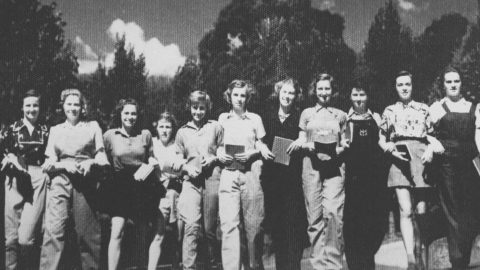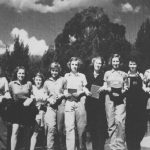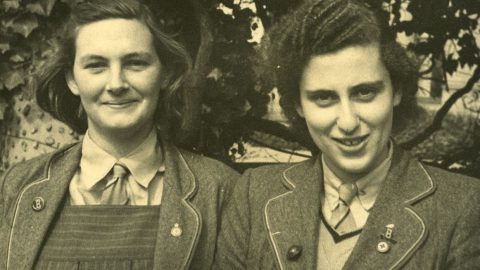
1942 – Warburton

Reflecting on Warburton
In 1942 as the Second World War actions edged closer to Australian soil, the St Catherine’s School site was vacated and became a training base for the WAAAF. On the 10 March 1942 the Australian Government took over the campus grounds and within two weeks the entire School population (280 girls) relocated to Warburton.
On the 10 March 1942 the Second World War arrived at St Catherine’s School with notice the campus was needed as a Medical Rehabilitation Unit for the RAAF. After a final assembly and a week of packing the 280 students and staff walked to Heyington Station and made the three hour train journey to the Chalet in Warburton where St Catherine’s School transformed from a predominately day school in the city into a country boarding school. For the girls of Warburton it was a time of adventure.
On the 14 November 2014 the students of 1942, Warburton Old Girls, were invited to attend a Principal’s Morning Tea to reconnect and share their memories of that time. They were also addressed by Principal, Mrs Michelle Carroll, 2014 SCOGA President, Mrs Deborah Berry and Dean of Year 10 and English and Literature Teacher, Ms Vasiliki Spanos. Following is part of Ms Spanos’ speech.
“This morning we honour you, the dear students of 1942, whose time in a little town some 80 kilometres east of Melbourne, has helped add to the rich tapestry of our School history, as well as
to the rich tapestry of Warburton, my home town.
I have spent much of the past couple of weeks reading your memories in Warburton Reminiscences and one point that came up quite often was indeed how cold it gets in Warburton. When the weather is cold, inevitably, people get closer to keep warm and it is clear that during your time in Warburton you came together in so many ways that I am sure words cannot fully express and we, from a very different time, may not even be able to imagine. Miss Sophie Borland’s words resonate deeply, ‘Looking back over this time, it seemed like a lifetime, but was actually only about eight
months, I see that there were things of positive value in the experience…All I think were influenced by the nearness of the bush and the hills. However, the growth of fellowship between girls and adults, forced into living in a new way and sharing the responsibilities and the problems, was – as I see it – the best thing that came out of the Warburton experience.’
The manner in which the School adapted and adjusted to the Warburton move in 1942 and the subsequent manner in which staff and students carried on and made the most of the situation,
has set the optimistic tone that represents an undeniable St Catherine’s School quality. Our ethos embraces challenges and certainly seeks to make the most of a situation, whilst simultaneously serving others. But where do these values come from? Family, society, faith, our personal experiences, and of course, our history. The history of our School has many examples of strong individuals, strong women dedicated to education, who loved their work and who led by example. The Warburton move, and everyone involved in it – students – teachers – parents – is one such instance and we are grateful for your input.
These girls, now women sitting in front of me, were asked to move and change their lifestyles, not on a whim. It was a time of war. The headlines of the day, allow us a way to understand what it
must have been like at the time. The Argus, on Monday, 24 March, 1942 ran with “Katherine and Darwin Bombed by Japs…Canberra, Sunday… Enemy aircraft attacked Katherine, in the Northern Territory, on the railway 160 miles south of Darwin, this afternoon, bombs were dropped, killing one aborigine and injuring another. Little damage was done during this raid, stated a communique issued by Mr Curtin, Prime Minister, Late tonight.” This was the social and political context, the reality, of the St Catherine’s School move to Warburton. It was a time of great sorrow and pain for so many. Again, what is emphasised and noteworthy in reading the School records is how the School community remained focused and resilient at such a challenging time in world history.
Warburton remains a quiet little town, just as it was in 1942, but I imagine there are a number of changes. The Chalet is gone. The Fruit Farm that is so fondly recalled by a number
of Old Girls, no longer exists. We have three churches, a community garden in the main stretch of the Warburton Highway in the town.
The old bakery is now a bookshop and the old petrol station is a bakery! We have a Vietnamese restaurant and an Indian Curry Club. The train no longer comes to Warburton, but the track
provides hours of pleasure to cyclists from around the state as they ride along the Lilydale-Warburton bike track. It is along this track that I walk and pass the property which was once, as one time a lady walking her dog told me, a school for girls. ‘I think’ (she said to me) ‘that there was a school here once …oh yes… it was St Catherine’s School. Have you heard of it? It is this fancy school in the city.’ I smiled at her and said that indeed I had.”
Ms Vasiliki Spanos
Dean of Year 10


